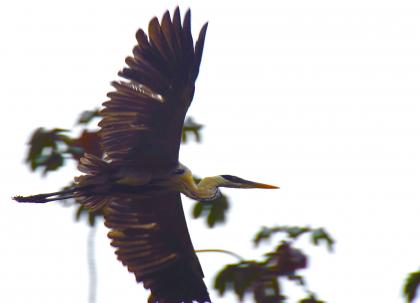5. Camp 2: A Day in an Ornithologist's Life - Part 1
We've arrived at Redondococha, our second camp for this inventory. We had a scary moment the first day, when a long and heavy wooden beam supporting one of our shelters fell and cracked Alvaro on the head. Luckily he is okay; we're all hugely relieved. Doug Stotz (see Photo #1 below), our Field Museum bird expert, will post the next two dispatches—I will be back for Güeppicillo, our third camp…
Corine
Day 2: By Doug Stotz
This is the second day at our second camp, on the shore of Redondococha (meaning "Round Lake") in Peru, along the Peru-Ecuador border. It starts before dawn, as field days typically do for ornithologists. A bit before 5 AM, I stumble out of my tent—where I’ve spent a not particularly restful night on a sleeping pad wrapped in a progressively smellier sheet—and head for camp where Debby Moskovits is already up and ready to leave on the trail.
My Ecuadorian counterpart, ornithologist Patricio Mena, arrives as I have my breakfast: a few crackers and what passes for cool water. I drink as much as I can stand, to be as hydrated as possible when I leave around 5:30 AM. I’ll carry a couple of liters of water and a couple of granola bars to tide me over until I get back to camp, which it turns out will be 1:30 PM today. Debby and Patricio head out separately so that we can cover as much of the trail system as possible each day, maximizing the number of birds we find.
My plan is to cover the lake edge. We’ve got a trail system with 19 km of trails laid out along three main paths, but we have four days and the lake edge is not covered well by these trails. This edge could easily have interesting bird species that we’re not seeing from camp. In part, I'm on the search for the Cocha Antshrike, a bird whose global range encompasses only northeastern Ecuador. If I find it here, it will be new for Peru. If don’t find it, hopefully some other interesting birds will (at least partially) make up for this along the lake edge.
I work in a southerly direction along the east side of the lake, walking on the exposed lakebed to a big grassy marsh area at the south end of the lake. Then I head up to the north end of the lake where there's a big shallow area with scattered vegetation.
As I head out, the lake water level is way down but actually seems slightly higher than yesterday, even though we’ve had no rain. Turns out that the Rio Aguarico, where the water from this lake ultimately goes, has risen dramatically due to rains in the headwaters and is now backing up into the Rio Lagartococha, which drains this area.
By the end of the day, water levels are up six feet, about where they were when the camp was created a couple of weeks ago by the Advance Team. It makes life easier, from bathing and getting drinking water to traveling out of here by boat in three days. Hopefully we won’t have to pull the boat through the marsh the way we did coming in. But the route I used around the lake will be under several feet of water after today, so I made the right choice to cover the lake.
The total number of birds I find along the lake edge is much smaller than I would get in the forest, but there are 20 new species for the site, with six species that we hadn’t seen yet at all—including a real highlight bird. At the south end, in the grassy marsh, an adult Azure Gallinule pops out and walks unsteadily across the tops of small shrubs poking out of the marsh.
This bird is a rare migrant into northern Peru from its breeding grounds in eastern Amazonia. It's the smaller, paler relative of the Purple Gallinule that occurs from Amazonia north all the way to the southern U.S. I’ve only seen a handful in my life, and I try to remember when the last one was. Best I can remember, it was in 1986 in Rio Grande do Sul, when I was down there in search of blackbirds with Scott Lanyon, who was then Curator of Birds at the Field Museum.
Less exciting but still new for the trip were a couple of calling Rufous-sided Crakes (a small rail that stays hidden in the grass), a Large-billed Tern (a large yellow-billed tern of the Amazon basin), a Capped Heron, a pair of Red-and-green Macaws that flew over (we’ve been seeing good numbers of Scarlet and especially Blue-and-yellow Macaws during the entire trip), and a flock of 85 Neotropic Cormorants that dropped in for about an hour at the north end of the lake and then took off (back to the river I guess) a few at a time.
By 9:40 AM, I conclude my trip around the lake and prepare to head into the forest. Stay tuned for my next dispatch to learn what I found there....
Doug
Written October 11, 2007





